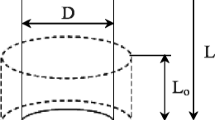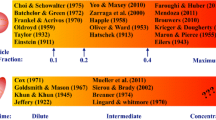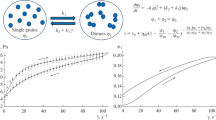Summary
From viscosity measurements on suspensions of spheres from the literature, the relation between relative viscosity and volume concentration was derived up to 0.5. This relation should be valid at room temperature for rigid smooth spheres, well dispersed without more than loose and random contacts, well wetted, without slip, in aNewtonian low viscous medium of about the same specific gravity, which spheres do not swell nor are electrical charged, whose diameter may vary between e. g. 0,3 and 400μ and whose particle size distribution may be moderately polydisperse. The relation ofη r andc is valid for all rates of shear up toc=0.25 and for sizeable shear rates above that concentration. For higher concentrations the viscosity figures are more uncertain, especially at very low shear rates. The viscosity behaviour abovec=0.5 is still largely unknown. There is still much need for more accurate experimental work on sphere suspensions of varying concentrations at varying rates of shear. There seem to be several critical concentrations, where the flow behaviour shows changes, e. g. atc=0.02–0.07–0.15–0.20 à 0.25–0. 45 −c max.
The relation betweenη r andc can be pictured in several ways. Starting from the assumption of a hyperbolic relation between someη r and somec term, several equations may be derived for the relation betweenη r andc.
Zusammenfassung
Aus den in der Literatur veröffentlichten Viskositätsmessungen an Kugelsuspensionen wird eine Beziehung zwischen der relativen Viskosität und der Volumenkonzentration (bis herauf zu 50%) abgeleitet. Diese Beziehung sollte gelten bei Raumtemperatur für starre, glatte Kugeln, die gut dispergiert sind und höchstens schwache, zufällig angeordnete Bindungen besitzen, gut benetzt werden und keine Gleitung zeigen, sowie für ein niederviskoses Newtonsches Suspensionsmittel, das weder Quellung noch elektrische Aufladung der Kugeln hervorruft. Der Kugeldurchmesser kann etwa zwischen 0,3 und 400μ, variieren, und es kann eine mäßig polydisperse Verteilung vorliegen.
Diese Beziehung zwischenη r undc ist bis zu einer Konzentration von 25% für alle Schergeschwindigkeiten gültig, oberhalb derselben jedoch nur für größere Geschwindigkeiten. Für höhere Konzentrationen werden die Viskositätsdaten unsicherer, insbesondere bei sehr niedrigen Schergeschwindigkeiten. Das Viskositätsverhalten oberhalb vonc=50% ist noch weitgehend unbekannt. Man benötigt hier noch genauere Messungen an Kugelsuspensionen als Funktion der Konzentration und der Schergeschwindigkeit. Es scheinen verschiedene kritische Konzentrationen zu existieren, bei denen das Fließverhalten sich ändert, und zwar bei etwa 2, 7, 15, 20–25, 45% undc max.
Die Beziehungen zwischenη r undc sind auf verschiedene Weisen darstellbar. Ausgehend von der Annahme einer hyperbolischen Beziehung zwischen einer Funktion vonc und einer Funktion vonη r können verschiedene Gleichungen abgeleitet werden.
Similar content being viewed by others
References
Maron, S. H. andSh. Ming Fok, J. Colloid Sci.10, 482 (1955).
Eilers, H., Kolloid-Z.97, 313 (1941).
Robinson, J. V., Trans. Soc. Rheol.1, 15 (1957).
Ting, A. P. andR. M. Luebbers, Amer. Inst. Chem. Eng. J.3, 111 (1957).
Sweeney, K. H. andR. D. Geckler, J. Appl. Phys.25, 1135 (1954).
Fidleris, V. andR. L. Whitmore, Rheol. Acta1, 573 (1961).
Ward, S. G. andR. L. Whitmore, Brit. J. Appl. Phys.1, 286 (1950).
Higginbotham, G. H., D. R. Oliver andS. G. Ward, Brit. J. Appl. Phys.9, 372 (1958).
Eveson, G. F., J. Oil Col. Chem. Ass.40, 456 (1957).
Eveson, G. F., J. Oil Col. Chem. Assoc.41, 150 (1958).
Eveson, G. F., inC, C. Mill, Rheology of Disperse Systems, 61–83 (London 1959).
Cheng, P. Y. andH. K. Schachman, J. Polym. Sci.16, 19 (1955).
Harvey, E. N., J. Colloid Sci.8, 453 (1953).
Eirich, F. et al. Kolloid-Z.74, 276 (1936).
Broughton, G. andC. S. Windebank, Ind. Eng. Chem.30, 407 (1938).
Williams, P. S., J. Appl. Chem.3, 120 (1953).
Robinson, J. V., J. Phys. Colloid Chem.55, 455 (1951).
Vand, W., J. Phys. Colloid Chem.52, 277, 300, 314 (1952).
Manley, R. St. andS.G. Mason, Can. J. Chem.32, 763 (1954).
Dobry, A., J. Chim. Phys.52, 809 (1955).
Maron, S. H., B. P. Madow andI. M. Krieger, J. Colloid Sci.6, 584 (1951).
Oden, Sven, Z. physik. Chem.80, 709 (1912).
Harmsen, G. J., J. v. Schooten andJ. T. G. Overbeek, J. Colloid Sci.8, 64 (1953).
Ford, T. F., J. Phys. Chem.64, 1168 (1960).
Saunders, F. L., J. Colloid Sci.16, 13 (1961).
Bancelin, M., Kolloid-Z.9, 154 (1911).
Harmsen, G. J., J. v. Schooten andJ. T. G. Overbeek, J. Colloid Sci.8, 72 (1953).
Donnet, J. B., J. Chim. Phys.48, 536 (1951).
Donnet, J. B., J. Chim. Phys.50, 380 (1953).
Broersma, G., J. Chem. Phys.28, 1158 (1958).
Happel, J., J. Appl. Phys.28, 1288 (1957).
Maron, S. H. andB. P. Madow, J. Colloid Sci.8, 300 (1953).
Bruyn, H. de, Disc. Faraday Soc.11, 86 (1951).
Rajagopal, E. S., Z. physik. Chem. N. F.23, 342 (1960).
Whitmore, R. L., J. Instit. Fuel.31, 422 (1958).
Roscoe, R., Brit. J. Appl. Phys.3, 267 (1952).
Scott, G. D., Nature188, 908 (1960).
Rigden, P. J., Road Res. Techn. Paper Nr. 28 (1954).
Guth, E. andR. Simha, Kolloid-Z.74, 266 (1936).
Oliver, D. R. andS. G. Ward, Nature171, 396 (1953).
Hess, W. R., Kolloid-Z.27, 1 (1920).
Author information
Authors and Affiliations
Rights and permissions
About this article
Cite this article
Rutgers, I.R. Relative viscosity of suspensions of rigid spheres in Newtonian liquids. Rheol Acta 2, 202–210 (1962). https://doi.org/10.1007/BF01983952
Received:
Issue Date:
DOI: https://doi.org/10.1007/BF01983952




